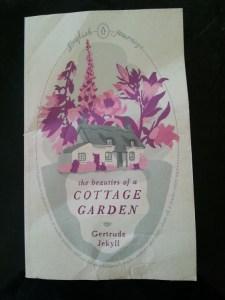I was given a book for Christmas. A cute little sized Penguin publication. It is entitled 'The Beauties of a Cottage Garden' by Gertrude Jekyll which is a condensed version of her most famous original - 'Wood and Garden'

For those who don't know recognise the name Gertrude Jekyll was a hugely influential garden designer and horticulturalist who was born in London in 1843. By the age of 89, when she died in 1932, she had designed over 400 gardens all over Britain, Europe and USA. So it's safe to say she knew what she was talking about plus, all that accomplishment was in a very male dominated society so extra respect to Gertrude!
'The Beauties of a Cottage Garden' was one of Jekyll's 15 books she wrote around gardens.
I love old horticultural books because while most advice goes out of date quite quickly (that goes for gardening books written today as much as 100 yrs ago), as knowledge has evolved, there are always some real gems to be read when written by wise people. I also enjoy the old way of explaining things or how in today's culture we'd find some of the writing pompous to read.
Like any old work of art though this book has to be taken in the context it was written. In 1899 life was a lot different and so was gardening. It was about grandiose displays of boarders, big houses with full time gardening staff, or a tenement space in the smoke filled cities. It was about experimenting with various plants but for many it was just about enjoying the pleasure that the plants gave to everyone at any social class (thanks to parks and allotments) and that is as true today. Gardening practices go through fashion just like any other industry but at it's heart plants are nature which can never be tamed.
Garden ShowsThis book wasn't pompous. Jekyll makes some fabulous commentary around plant shows. I went to a plant show once and it was the most unappealing side I've ever seen to gardening. Great big displays that could never be used in any practical fashion. Flower head so big they had to be supported by various means and vegetables that made me feel I was Alice, from Alice in Wonderland - not to mention the rather brutal comments left at the side of the displays by the judges. Put me off for life.
Jekyll in no way condemns shows but she makes the reader think about why we must be cautious with them.
for I venture to repeat that what we have to look for for the benefit of our gardens, and for the bettering and increase in those gardens, are things that are beautiful, rather than things that are round, straight, or thick, still less than for those that are new, or curious, or astonishing.
People can be very snobby when it comes to gardens and planting, which is why it can put some folk asking for advice or not starting anything at all. But that isn't what gardening is about. It's about learning, in your own way. Making mistakes and trying again, and again, until you're happy with the end results and this is what Jekyll is always keen to point out in this book.
Learning something newI wasn't sure I'd actually learn anything from the book, because it's more of a muse than a detailed 'how to book' but I was surprised to read a gem on primroses. Not a flower I've ever given much thought to but Jekyll lays down the positive contribution these plants can make to any garden and more importantly how easy they are to grow and multiply in any space.
The seed is sown in boxes in cold frames, and pricked out again into boxes when large enough to handle. The seedlings are planted out in June, when they seem to go on without any check whatever, and are just right for blooming next spring
I always saw primroses as bedding plants in garden centres, planted into place for early summer colour to then be chucked away for something else later on. But oh no...they are perennials and hardy at that.
Low and behold while wondering around our garden last weekend I came across a single primrose that was planted in a pot years ago. It keeps coming back every year. I ( in a very snobby tone myself, I am ashamed to admit) kept dejecting the plant thinking it was just going to die but of course, it hasn't. And while it is of the garish pink colour, rather than the more traditional yellow, I now look at that plant in awe. It's also given me ideas about growing some more primroses from seed and transplanting them beneath the cob nut hedge, just like Gertrude Jekyll did with hers.
Such a tiny book has not only enforced my own core values around gardening but has opened up a whole new world of flowering colour to try out. Who says we can't learn anything from the past!
Are you a fan of Gertrude Jekyll's practical and wise writings? Have you ever learnt something new from an old book?_____________
Extracts from The Beauties of a Cottage Garden by Gertrude Jekyll
